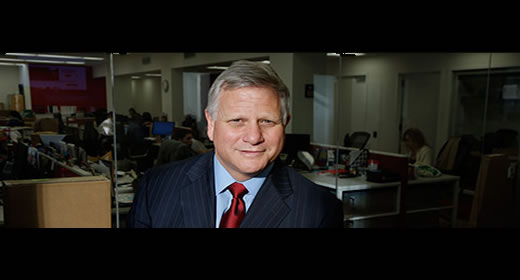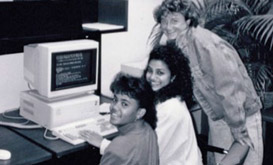
Peter Borish applies analytics and creativity to for-profit and not-for-profit endeavors alike
"I was like every other kid," says Peter Borish (AB '81, MPP '82). "When I was growing up, I wanted to become a professional baseball player."
Like almost every other kid, he didn't. But if he wasn't the Rookie of the Year in his chosen field, he came close. Five years after earning his master's at the Ford School, the hedge fund he co-founded with Paul Jones, Tudor Investments, was already so successful that he, Jones, and another hedge fund executive were able to create the Robin Hood Foundation, now the largest anti-poverty organization in New York City.
It was 1987, and the methodology he and Jones developed for predicting, and profiting from, volatility in the then-nascent derivative markets had kept them prosperous despite that year's stock market crash. The disparity between their lot and that of so many others brought them to the "giving back" phase of their careers earlier than most.
"We felt—and, by the way, we were wrong on this—that the crash would have a similar economic impact as the one in 1929," Borish recalls, "and that New Yorkers and those in need would be really suffering for a long time. We had a decision to make: buy or build, give money to another not-for-profit or start our own. Being analytical, and wanting to try to measure impact, we decided to build our own."
Being analytical, their first realization was that "the three of us were pretty good at making money but that didn't mean we knew anything," he says. "There's a fallacy that people who make money know something about everything. We knew something about markets but we didn't necessarily know how to build a nonprofit."
They brought in a seasoned team of stars in the not-for-profit world to do that, but they also brought their business acumen to the table.
 |
|
Students with Borish-donated computer, 1990 |
"Robin Hood, in a nutshell, goes back to the first course I ever had at the Ford School on benefit-cost analysis," says Borish. "If I only had one dollar to give, who would I give it to? How do I measure its impact?"
They implemented three principal innovations that were all, in a way, answers to those questions: the foundation has no endowment, its board pays all overhead costs, and it has an institutionalized assessment component.
"If I'm convincing you to give a dollar to Robin Hood," he says, "that dollar will be spent over the next 12 months, it's not going to be 87 cents because 13 cents goes to overhead, and because we actually have a metrics committee, you'll know we take a very analytical approach in measuring our program."
Borish describes himself as a "serial entrepreneur. Most of my success has been in the hedge fund business. Once I made a decision to leave the hedge fund business, I focused on early stage technology investing." It's not a typical path for a Ford School alum, but he still credits his "coaches" there for the approach that led to his success.
"The Ford School helped me think analytically," he says. "That's what people need today. Excel can tell me what two plus two is. One differentiates oneself in the marketplace by being analytical. And it's not just analysis; you have to be able to think creatively about the questions to ask. If you're just asked questions and you have to answer them, you're studying for the test. Success in business, and particularly in the market, is not about tests. Every day the market opens and it's a new test."
Grasping the difference between knowing answers and knowing how to think about finding answers is "where the Ford School comes into play," says Borish. "It's a very subtle distinction, but I think that's something the Ford School does better than anyone else."
He uses a sports metaphor to limn the core insight that's helped keep him in the investment game for more than three decades. "As athletes get faster and stronger, the game has to evolve," he says. "It's the same thing with the market; there's always this game of innovation."
That insight also applies to the philanthropy game. In 2005, Borish was one of the founding investors of charitybuzz.com, a for-profit internet company that raises funds for nonprofit organizations through online charity auctions of items like meetings with celebrities and high-end or one-of-a-kind merchandise.
"Getting markets and not-for-profits to work together just happens to be really cool and something I love," he says. "We do things on charitybuzz that not-for-profits never do." Last year's highest bid, for example, was for coffee with Tim Cook, the CEO of Apple.
"That went for a little over $600,000, and the beneficiary was the Robert F. Kennedy Foundation for Criminal Justice," he says.
"Tim donates some time and helps raise a lot of money for RFK, the buyer gets access to someone he would never have been able to get access to, and the foundation, after our fee, gets more money off that auction than most not-for-profits will ever get from a live benefit. In economic terms, that's about pareto optimal as you can get, a win-win for everybody."
Perhaps his path hasn't been all that anomalous for a Ford School alum.
"People ask, 'What is public policy?'" he says. "I answer that it's anything you want it to be. Super PACs, 501(c)(4)s, nonprofits, these are all measures designed to affect public policy. You sit in a room asking questions about what's the best way to go about doing this, and they're all analytical questions, all data-driven. That analytical seed that the Ford School planted touches everything that I do."
--Story by Jeff Mortimer, Photo by Heidi Gutman
Below is a formatted version of this article from State & Hill, the magazine of the Ford School. View the entire Spring 2014 State & Hill here.